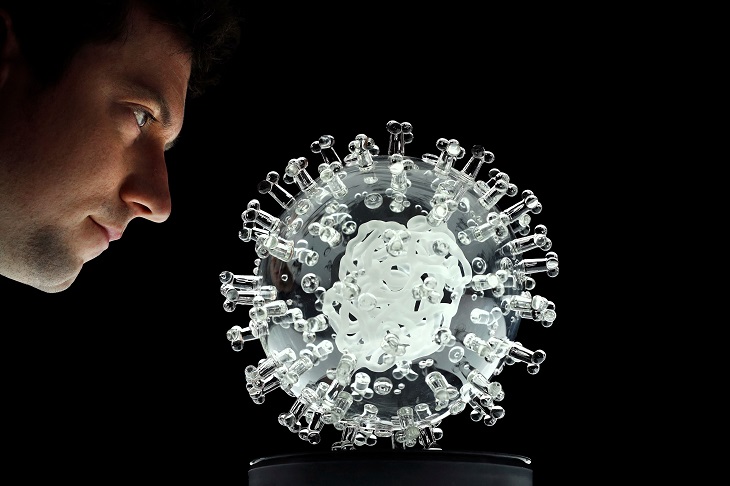‘Pandemic’ might be the first prominent ‘P-word’ one might use to describe the period between 2020-22, and now ‘polarising’ very well might be the second. Ever-growing are the controversies encompassing Covid – take the politicisation of the virus’ origin, for one. One scientist, who claims to reject politics and pursue only scientific data, is Professor Nikolai Petrovsky. He is the director of endocrinology at Flinders Medical Centre, as well as the chairman and research director of Vaxine: an Adelaide-based biotechnology group.
‘Science’s view is that, you know, bring the facts. We’re not interested in your opinion – show us the facts. That’s what I’ve grown up with: a fact-based system,’ he emphasised, sitting in his living room: a place neatly adorned with framed photos of relatives – many of whom were also scientists.
Petrovsky’s research team focuses primarily on vaccine development, having – over the span of 20 years – received over 50 million dollars in funding from the United States government via the National Institutes of Health. He says that for the US to consistently fund an Australian research group outside of itself is a major achievement and a testament to the rigour of his small team.
‘Not only do we have to equal the best in the US – we’re talking Harvard, Stanford, they’re our competitors – we have to be way above them to justify actually giving us the money.’
During the process of developing their own Covid vaccine, Petrovsky and his team used AI and supercomputers to create a model of the virus by using its gene sequence – a publicly available resource via the National Institutes of Health. This happened in early January 2020 when Covid had not yet entered Australia.
‘We were saying: “Look, we’ve made this model of the virus and we understand what we believe the virus looks like, and how it’s infecting cells. Maybe we can use this computer modelling to understand where the virus came from?”’ Petrovsky said.
This led to the team’s Covid origin study, founded upon the idea that the virus originated from an animal. This remains consistent with the information published in 2020 by the Australian Department of Health about the virus’ likely origin from bats in a Wuhan seafood market.
‘We set about using our modelled virus and our supercomputers to try and understand – was it a civet cat, or was it a monkey, or some other animal,’ Petrovsky said.
‘The way it works, is we could simulate how well the virus bound to the cells of all those different animals. What we were predicting is that the animal that the virus had come from, it should bind best to that cell, because it’s evolved to infect that animal, you know, maybe over long periods of time. Therefore, it should be really good at infecting that animal: that’s how it survived.’
Petrovsky says his team used in silico procedures to rank the many types of exotic animals that could be potential candidates, as well as humans:
‘We were very surprised when we did this and ranked them that humans were actually right out on top – which, if you went by our original hypothesis, well that’s where it [the virus] came from.
‘To this day, no one has found any data that would suggest we got it wrong. In fact, as I say, the Chinese scientists themselves, and the American scientists, have beautifully confirmed that that’s exactly how it is. So, the model wasn’t wrong, the results are true.’
Available are Petrovsky’s team’s peer-reviewed study and the subsequent studies of the Chinese and American scientists.
‘Even though people might’ve tried to criticise us back then because it was a model, the fact is: now there’s physical data that proves that we were right. So, you’re still left with this difficulty in how do you explain that result,’ Petrovsky said.
He says one possible explanation is that the virus could have been unintentionally adapted to humans. If the virus wasn’t in a human, the only way it could have been adapted was in a lab, where it could rapidly adapt to human cells inside a test tube.
‘Scientists do this all the time, like we’ll take a human virus and adapt it to infect a mouse. This is really standard stuff that people do when they handle viruses – so you can change the species that a virus infects in a test tube,’ he said.
‘Viruses are invisible, so it doesn’t even require that someone know that this is happening in their experiment. So, in no way were we implying that someone had done this deliberately.’
According to Petrovsky, upon his team’s first appeal for publication, the paper was rejected by many major journals – often returned within 48 hours with no reason as to why:
‘Ultimately it did get published a year later, so there was nothing wrong in the work. Obviously politically there’d been a decision taken within a lot of the leading journals that they were not going to publish anything that actually pointed to a non-animal origin.’
Petrovsky has demonstrated his use of AI in medical research for over 25 years – a time period in which he says some scientists have shunned the idea of AI experiments. So, how does he prove these methods are reliable?
He says the cruciality lies in testing the result of an AI experiment with that of a physical experiment to ensure the results are in alignment. If the two agree, it means whatever is happening in the AI is working – particularly if this is tested repeatedly.
‘You prove the AI is working, and at that point you stop – except in some select cases – you stop having to do the physical experiment, you can trust the AI … But if you had to run the experiment in a computer and then always run the physical experiment, that defeats the purpose,’ Petroski said.
Associate Professor Maurizio Costabile specialises in Biochemistry and Immunology Education at the University of South Australia. He says the growing power of AI has been observable for a number of years – via grammar functions like autocorrect, and more recently, ChatGPT – but emphasises the importance of a human mediator when it comes to using it in the realms of science:
‘I think any tool that we can develop that is able to help us analyse data in a better way – still with obviously a human thought, a human interaction, and a human understanding of what the results actually mean – is something that could certainly be useful, and something that might actually facilitate new discoveries and the advancements of science,’ Costabile said.
According to Professor Petrovsky, if scientists were to try and find a drug ‘in the old days’, they might make ten molecules and test them in the lab. This reached a point where scientists wanted to test hundreds of thousands, millions, even trillions of compounds. Even in massive factories, this could not be physically achieved.
‘Yet we’re saying the computer can do that trillion experiments just as fast as it can do a single experiment! In fact, we got to the point where we tested 10 to the power of 18 … that’s how many compounds we were testing in one run on the computer. Now that would take millions of years of human time,’ he said.
Discovered among this number was Vaxine’s drug for swine flu which entered US clinical trials in 2019: the first drug in the world to be completely designed by AI.
Got something to add? Join the discussion and comment below.
Get 10 issues for just $10
Subscribe to The Spectator Australia today for the next 10 magazine issues, plus full online access, for just $10.


























Comments
Don't miss out
Join the conversation with other Spectator Australia readers. Subscribe to leave a comment.
SUBSCRIBEAlready a subscriber? Log in